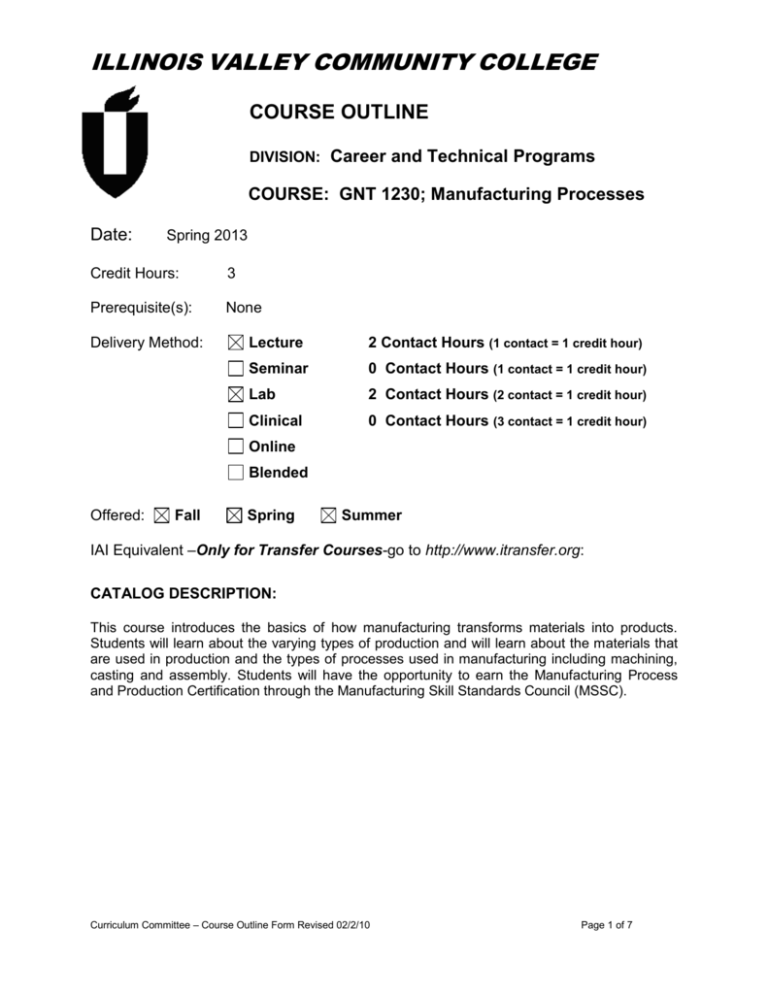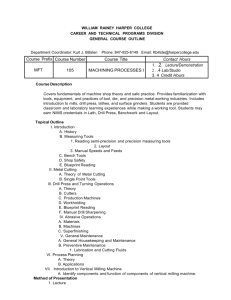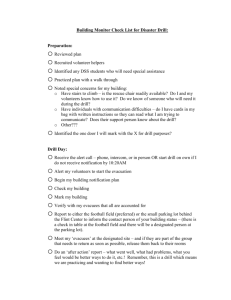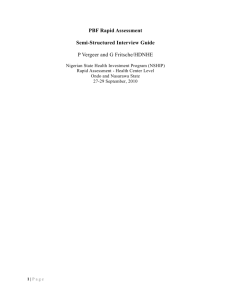course outline - INAM: Illinois Network for Advanced Manufacturing
advertisement

ILLINOIS VALLEY COMMUNITY COLLEGE COURSE OUTLINE DIVISION: Career and Technical Programs COURSE: GNT 1230; Manufacturing Processes Date: Spring 2013 Credit Hours: 3 Prerequisite(s): None Delivery Method: Lecture 2 Contact Hours (1 contact = 1 credit hour) Seminar 0 Contact Hours (1 contact = 1 credit hour) Lab 2 Contact Hours (2 contact = 1 credit hour) Clinical 0 Contact Hours (3 contact = 1 credit hour) Online Blended Offered: Fall Spring Summer IAI Equivalent –Only for Transfer Courses-go to http://www.itransfer.org: CATALOG DESCRIPTION: This course introduces the basics of how manufacturing transforms materials into products. Students will learn about the varying types of production and will learn about the materials that are used in production and the types of processes used in manufacturing including machining, casting and assembly. Students will have the opportunity to earn the Manufacturing Process and Production Certification through the Manufacturing Skill Standards Council (MSSC). Curriculum Committee – Course Outline Form Revised 02/2/10 Page 1 of 7 GENERAL EDUCATION GOALS ADDRESSED [See the last page of this form for more information.] Upon completion of the course, the student will be able: [Choose those goals that apply to this course.] To apply analytical and problem solving skills to personal, social and professional issues and situations. To communicate orally and in writing, socially and interpersonally. To develop an awareness of the contributions made to civilization by the diverse cultures of the world. To understand and use contemporary technology effectively and to understand its impact on the individual and society. To work and study effectively both individually and in collaboration with others. To understand what it means to act ethically and responsibly as an individual in one’s career and as a member of society. To develop and maintain a healthy lifestyle physically, mentally, and spiritually. To appreciate the ongoing values of learning, self-improvement, and career planning. EXPECTED LEARNING OUTCOMES AND RELATED COMPETENCIES: [Outcomes related to course specific goals.] Upon completion of the course, the student will be able to: 1. 2. 3. 4. 5. 6. 7. 8. 9. 10. 11. 12. 13. 14. 15. Interpret specifications, work orders, and technical drawings Identify the major stages of production, production resources, and factors for production method selection Identify the characteristics and advantages of major types of production systems Six (6) types of simple machines, operation and applications of levers, and concepts of force and weight Describe the effect of friction on machine operation; operation of machine linkages, cams, and turnbuckles Identify types, properties, and applications of materials and chemicals used to manufacture products, including food and beverage products Identify factors used to select materials for a given product, methods of testing material quality, and advances in material design Describe types, operation and application of casting, molding, machining, finishing, assembly, separation, conditioning, combining, and filling Interpret stock material sizes and types from specifications; use a band saw to cut stock material to size; types of machine tools Use basic layout techniques to prepare a part for machining, size a drill bit, identify drill by size, select and install drill press tooling, operate a drill press Use a drill press to perform basic drilling operations: reaming, counterboring, countersinking, and tapping Identify types, applications and use of hand tools, portable power tools, and equipment Interpret standard operating procedures; read technical manuals to obtain information; Total Productive Maintenance; machine operation procedures Describe basic concepts of production planning, work flow, and facilities layout; identify bottlenecks and ways to balance workflow, Lean manufacturing concepts, product cost estimating Describe types of inventory and inventory management concepts; read a bill of material; identify cost of downtime and calculate product cost Curriculum Committee – Course Outline Form Revised 02/2/10 Page 2 of 7 16. 17. 18. 19. Describe the operation of push and pull production systems, just-in-time production, methods of feedback to control quality Identify the types of production documents, methods of retaining documents, and use of electronic data exchange; read and handle production documents Identify the types and applications of product packaging; packaging regulations and laws; select packaging for given product; interpret package labels Describe methods and applications of transporting produced products; interpret shipping documents; use a tracking system COURSE TOPICS AND CONTENT REQUIREMENTS: I. II. III. IV. V. VI. VII. VIII. IX. X. XI. XII. XIII. XIV. XV. XVI. XVII. XVIII. XIX. Customer Contact Creating Products Types of Production Mechanical Principles Mechanical Linkages Production Materials Testing, Selecting, and Developing Materials Production Processes Machining Processes Machine Tooling Machine Operations Tools and Equipment Use Equipment Procedures Production Planning and Workflow Production Components Production Control Documenting the Process Product Packaging Product Distribution INSTRUCTIONAL METHODS: 1. 2. 3. 4. Lecture Demonstration Problem solving and discussion MSSC online e-Learning modules INSTRUCTIONAL MATERIALS: Manufacturing Skill Standards Council, High-Performance Manufacturing, Woodland Hills, CA, 2006 STUDENT REQUIREMENTS AND METHODS OF EVALUATION: 1. 2. Tests and quizzes Student presentations OTHER REFERENCES Curriculum Committee – Course Outline Form Revised 02/2/10 Page 3 of 7 “This workforce solution was funded by a grant awarded by the U.S. Department of Labor’s Employment and Training Administration. The solution was created by the grantee and does not necessarily reflect the official position of the U.S. Department of Labor. The Department of Labor makes no guarantees, warranties, or assurances of any kind, express or implied, with respect to such information, including any information on linked sites and including, but not limited to, accuracy of the information or its completeness, timelines, usefulness, adequacy, continued availability, or ownership. This solution is copyrighted by the institution that created it. Internal use, by an organization and/or personal use by an individual for non-commercial purposes, is permissible. All other uses require the prior authorization of the copyright holder.” Curriculum Committee – Course Outline Form Revised 02/2/10 Page 4 of 7 Course Competency/Assessment Methods Matrix Curriculum Committee – Course Outline Form Revised 02/2/10 X X X X X X X X X X Page 5 of 7 Assignment Written Report Interview Simulation In Class Feedback Licensing Exam Internship/Practicum /Site Supervisor Evaluation X X X X X X X X X X X X X X X X X X X X X X X X X X X X X X X X X X X X X X X X X X X X X X X X X X X X X X X X X X X X X X X X X X X X X X X X X D Article Review Case Studies Group Projects Lab Work Oral Presentations Pre-Post Tests Quizzes Written Exams Artifact Self Reflection of Growth Capstone Projects Comprehensive Written Exit Exam Course Embedded Questions Multi-Media Projects Observation Writing Samples Portfolio Evaluation Real World Projects Reflective Journals Applied Application (skills) Test Oral Exit Interviews Accreditation Reviews/Reports Advisory Council Feedback Employer Surveys Graduate Surveys X 1. Interpret specifications, work orders, and technical drawings 2. Identify the major stages of production, production resources, and factors for production method selection 3. Identify the characteristics and advantages of major types of production systems 4. Six (6) types of simple machines, operation and applications of levers, and concepts of force and weight 5. Describe the effect of friction on machine operation; operation of machine linkages, cams, and turnbuckles 6. Identify types, properties, and applications of materials and chemicals used to manufacture products, including food and beverage products 7. Identify factors used to select materials for a given product, methods of testing material quality, and advances in material design D D D D D D D D D D D D D D D D D D D I I I I D Assessment Measures – Are direct or indirect as indicated. List competencies/outcomes below. Direct/ Indirect For each competency/outcome place an “X” below the method of assessment to be used. Assessment Options Assessment of Student Learning GNT 1230; Manufacturing Processes Curriculum Committee – Course Outline Form Revised 02/2/10 X X X X X X X X X X Page 6 of 7 Assignment Written Report Interview Simulation In Class Feedback Licensing Exam Internship/Practicum /Site Supervisor Evaluation X X X X X X X X X X X X X X X X X X X X X X X X X X X X X X X X X X X X X X X X X X X X X X X X X X X X X X X X X X X X X X X X X X X X X X X X X D Article Review Case Studies Group Projects Lab Work Oral Presentations Pre-Post Tests Quizzes Written Exams Artifact Self Reflection of Growth Capstone Projects Comprehensive Written Exit Exam Course Embedded Questions Multi-Media Projects Observation Writing Samples Portfolio Evaluation Real World Projects Reflective Journals Applied Application (skills) Test Oral Exit Interviews Accreditation Reviews/Reports Advisory Council Feedback Employer Surveys Graduate Surveys X 8. Describe types, operation and application of casting, molding, machining, finishing, assembly, separation, conditioning, combining, and filling 9. Interpret stock material sizes and types from specifications; use a band saw to cut stock material to size; types of machine tools 10. Use basic layout techniques to prepare a part for machining, size a drill bit, identify drill by size, select and install drill press tooling, operate a drill press 11. Use a drill press to perform basic drilling operations: reaming, counterboring, countersinking, and tapping 12. Identify types, applications and use of hand tools, portable power tools, and equipment 13. Interpret standard operating procedures; read technical manuals to obtain information; Total Productive Maintenance; machine operation procedures 14. Describe basic concepts of production planning, work flow, and facilities layout; identify bottlenecks and ways to balance workflow, Lean manufacturing concepts, product cost estimating D D D D D D D D D D D D D D D D D D D I I I I D Assessment Measures – Are direct or indirect as indicated. List competencies/outcomes below. Direct/ Indirect For each competency/outcome place an “X” below the method of assessment to be used. Assessment Options Assessment of Student Learning GNT 1230; Manufacturing Processes Curriculum Committee – Course Outline Form Revised 02/2/10 X X X X X X Page 7 of 7 Assignment Written Report Interview Simulation In Class Feedback Licensing Exam Internship/Practicum /Site Supervisor Evaluation X X X X X X X X X X X X X X X X X X X X X X X X X X X X X X X X X X X X X X X X X X X X X X X X X X X X X D Article Review Case Studies Group Projects Lab Work Oral Presentations Pre-Post Tests Quizzes Written Exams Artifact Self Reflection of Growth Capstone Projects Comprehensive Written Exit Exam Course Embedded Questions Multi-Media Projects Observation Writing Samples Portfolio Evaluation Real World Projects Reflective Journals Applied Application (skills) Test Oral Exit Interviews Accreditation Reviews/Reports Advisory Council Feedback Employer Surveys Graduate Surveys X 15. Describe types of inventory and inventory management concepts; read a bill of material; identify cost of downtime and calculate product cost 16. Describe the operation of push and pull production systems, just-in-time production, methods of feedback to control quality 17. Identify the types of production documents, methods of retaining documents, and use of electronic data exchange; read and handle production documents 18. Identify the types and applications of product packaging; packaging regulations and laws; select packaging for given product; interpret package labels 19. Describe methods and applications of transporting produced products; interpret shipping documents; use a tracking system D D D D D D D D D D D D D D D D D D D I I I I D Assessment Measures – Are direct or indirect as indicated. List competencies/outcomes below. Direct/ Indirect For each competency/outcome place an “X” below the method of assessment to be used. Assessment Options Assessment of Student Learning GNT 1230; Manufacturing Processes



